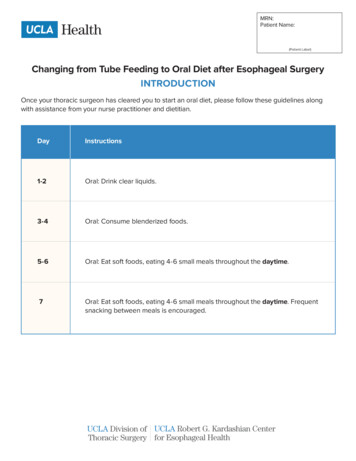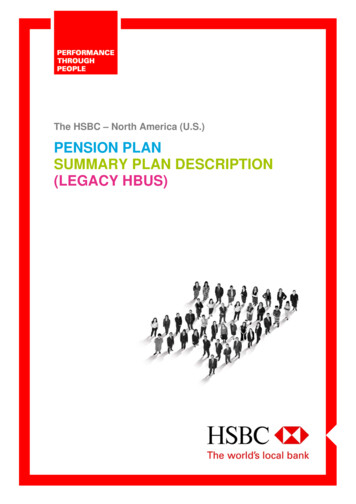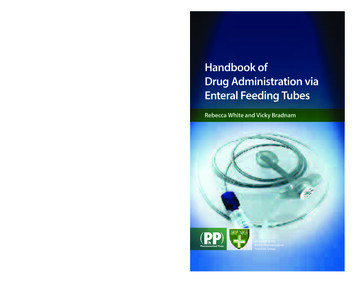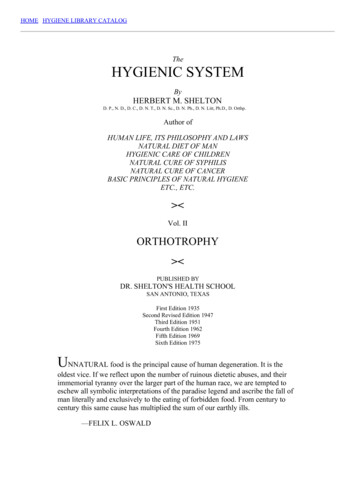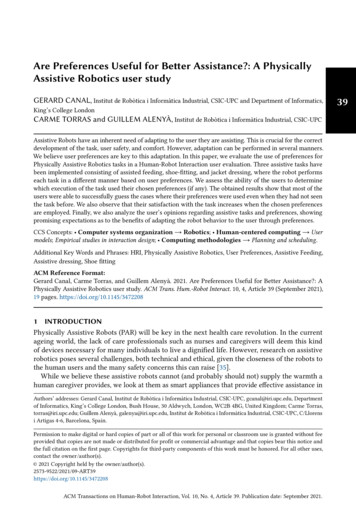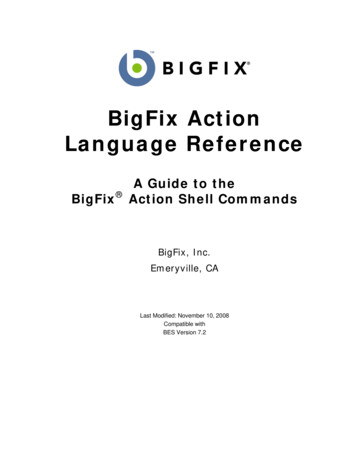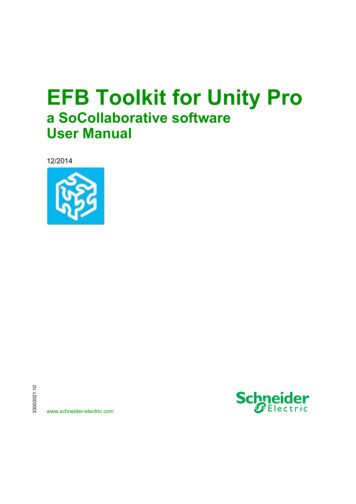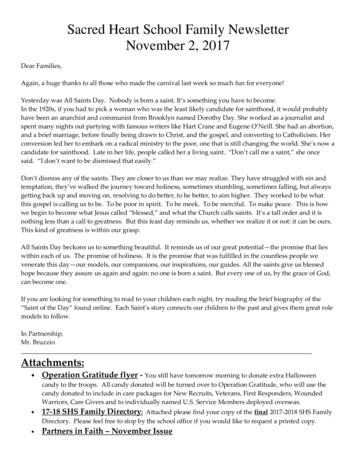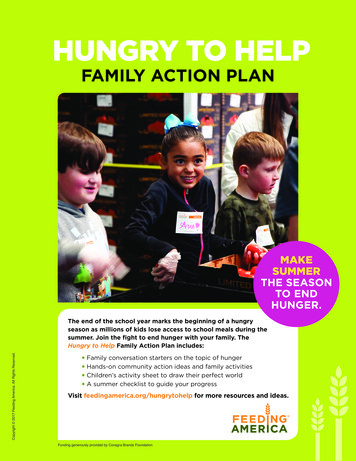
Transcription
HUNGRY TO HELPFAMILY ACTION PLANMAKESUMMERTHE SEASONTO ENDHUNGER.Copyright 2017 Feeding America. All Rights Reserved.The end of the school year marks the beginning of a hungryseason as millions of kids lose access to school meals during thesummer. Join the fight to end hunger with your family. TheHungry to Help Family Action Plan includes: Family conversation starters on the topic of hungerHands-on community action ideas and family activitiesChildren’s activity sheet to draw their perfect worldA summer checklist to guide your progressVisit feedingamerica.org/hungrytohelp for more resources and ideas.Funding generously provided by Conagra Brands Foundation
DEAR FAMILIES,One in six children in the U.S. do not have enough to eat.Right here in America, more than 13 million children don’t have enough to eat. Summer is anespecially tough time for children who face hunger. When school ends, so do the school lunches onwhich millions of kids rely—sometimes as the only meal they are sure to get during the day. Childrenneed proper nutrition to grow and learn, making hunger an urgent problem that needs to be solved.This guide will provide ways for you to talk to your child about hunger, help your child developempathy for others, and take action as a family. “Ways to Approach the Topic of Hunger With YourChild” gives suggestions for how to have conversations about this sensitive topic. “CommunityAction Ideas” lists ways that your family can fight hunger both at home and in the community, andthe children’s activity sheet will help you and your child get creative and imagine a world withouthunger. And since change does not happen overnight, the “Summer Checklist” provides a referenceto keep your child engaged in this issue.To get started, read two real stories from people facing hunger. Discuss how each of you might feelif you were dealing with hunger. Then review the action plan to identify steps your family can taketo help those in your community who don’t have enough to eat.STORY 1“My mom works really hard to make sure meand my brother have a roof over our heads andenough to eat. When we’re eating, she’ll makesure we eat first and are full. Then if there’sleftovers she’ll make dinner for herself. I get freelunch and breakfast at school, which helps mymom make sure we have enough food for theweekends. Without the lunch program, I wouldbe sad. To everyone who makes it possible I wantto say thank you. Because you’re making kids likeme happy and our parents happy too, by makingit easier for all of us to get enough to eat.”STORY 2“I’m a painter and I work a lot. Most weeks Iwork six days, from sunup to sundown, to makeenough to support my family. It’s barely enough,however, and I cannot always depend on thepaychecks since my work is so dependent on theweather. If it rains and I miss two days—those aretwo days I do not get paid. Those are two days ofpay my family cannot afford to miss.“As a father, it is so painful when your child asksyou for something to eat and you cannot provideit for her. My daughter would say, ‘Can I havesome milk?’ And I would have to say, ‘I’m sorry Idon’t have milk.’ That’s really, really hard to say.”2
CONVERSATION STARTERSWays to Approach the Topic of Hunger With Your Child1. Make it relevant.Encourage your child to puthimself or herself in someoneelse’s shoes. What would heor she think and feel if therewasn’t enough to eat? Shareinformation about what ishappening in your city with theMap the Meal Gap resource atmap.feedingamerica.org.5. Encourage childrento talk about theiremotions. Help your childunderstand that it’s okay tofeel sad or frustrated aboutproblems they see in theworld, including hunger. Makesure to discuss the ways thatyour child can take action tohelp solve these problems.2. Teach throughexample. Designate a jar to6. Engage them withtheir own imaginations.collect money for a hungerrelief organization, and addyour own spare change.Suggest bringing meals topeople in your communitywho may be ill or facing afamily emergency, and inviteyour child to help.Ask your child to describehis or her perfect world.What creative ways can yourchild come up with to solveproblems like hunger? Haveyour child draw and color hisor her perfect world usingpage 6 of this guide.3. Share your ownstories. Perhaps you have7. Show them how theycan make a difference.a meaningful volunteerexperience, or perhaps youhave experienced hungeryourself. Sharing theseexperiences will help yourchild make a personalconnection to the issue.Prepare meals for a localmeal program, collect foodfor the local food pantry, ortake part in a walk to endhunger. Getting involved in4. Provide anexplanation.Explain that there aremany reasons why peoplesuffer from hunger and thatthey may face hunger fordifferent lengths of time.If you and your child haveunanswered questions,visit feedingamerica.org formore information.direct service, such as servingmeals to people in need orvolunteering at a food bank,can help children connect tothose affected by hunger.8. Inspire them to makechoices. If your familydecides to make a monetarydonation, involve your child inthe decision about where themoney should go. If a birthdayor holiday is coming up, giveyour child a choice of makinga donation of food or moneyto a food bank or pantry inyour community.9. Make a plan for yourfamily. Show your childthat ending hunger willnot happen overnight—it’simportant to have a long-termplan. Use the CommunityAction Ideas (page 4) andSummer Checklist (page 7)to guide you.3
COMMUNITYACTION IDEASBy encouraging empathy athome and in your community, youcan inspire and empower yourkids to take action. Use the listbelow to decide which actionsare right for your family.ENCOURAGEEMPATHY1“I’m Thankful” collage: Discuss what youand your child are grateful for. Be sure to helpyour child understand that not all children havethe things that he or she may take for granted.Create an “I’m Thankful” collage based on whatyou discuss.2Recommended reading list: Reading stories are a great way for children tounderstand the complex realities of other people’s situations. Picture books that dealwith hunger include: Maddi’s Fridge by Lois Brandt One Potato, Two Potato by Cynthia DeFelice Uncle Willie and the Soup Kitchen by Dyanne DiSalvo-RyanConsider adding them to your family’s read-aloud list.3Write for change: Have your child write a story from the perspective of someonewho is facing hunger. Depending on your child’s age, he or she may want to rely onpictures as well as words to tell the story. Try the following writing prompts: What if you come home from school and there is not any food for a snack ordinner. What would you think and feel? What if your family did not have enough food for breakfast. What might youand your family have to do?4
TAKE ACTIONAT HOME4Create your own collectionbox: Find a spot in your houseto collect food items to donateto a local food pantry, as wellas a donation jar for monetarycontributions. Involve your childin the process by inviting him orher to decorate the box or jarand to help decide where thedonations should go.5Create a fundraiser: Raise fundsfor Feeding America or your localfood bank with a lemonade standor host a birthday party whereguests are asked for donationsinstead of presents. Visitfeedingamerica.org/fundraise foronline tools to organize your ownfundraiser, spread the word, andtrack your progress.6Plant a family garden: Use youroutdoor space to plant a gardenand collect the food to donate toa local food pantry. This projectwill also engage your child inefforts to fight hunger as wellas to promote sustainability. Ifyour family would like to expandthis idea, consider working withothers in your area to create acommunity garden.ENABLE ACTION789Draw for change: Introduce yourchild to artists who use art toconvey a message. Examplescould include Frida Kahlo andJR’s Inside Out Project. Inviteyour child to turn his or herhunger-fighting ideas into adrawing or a mural. Inspireothers with your child’s artworkby sharing on social mediawith @FeedingAmerica and#hungrytohelp.Hold a community food drive:Work together with a camp,church, or local supermarketto organize a community fooddrive. Your child will see the hugeimpact that a group of peopleworking together can have.Volunteer: Find family volunteeropportunities through your localfood bank. Your child will beable to see the effects of theirhard work through the amountof food donations sorted orthe number of meals served, aswell as getting to know peopledirectly affected by hunger. Tofind your local food bank, visitfeedingamerica.org/foodbank.5
HUNGRY TO HELP DRAW YOUR PERFECT WORLDEngage your child’s imagination and ask him or her to describe the perfect world. How can thisworld be free of problems such as hunger? Get creative with your child and draw what this perfectworld might look like together!6
SUMMER CHECKLISTTO HELP END HUNGERCreate a donation jar and start contributing money.Buy extra food items to donate to the food pantry.Share food with someone in need.Contact your local food bank to ask how you can help.Invite a friend to volunteer with you at a food bank.Read a book or a news article that deals with hunger or other issues.Organize a community food drive or a local fundraiser.Our own idea:Visit FeedingAmerica.org to learn moreabout hunger and how you can help.7
Feeding America is the largest hunger-relief organization in the United States.Through a network of 200 food banks and 60,000 food pantries and meal programs,we provide meals to more than 46 million people each year. Feeding America alsosupports programs that prevent food waste and improve food security among thepeople we serve; educates the public about the problem of hunger; and advocatesfor legislation that protects people from going hungry.MissionThe mission of Feeding America is to feed America’s hungry through a nationwidenetwork of member food banks and engage our country in the fight to end hunger.HOW FEEDING AMERICA PROVIDES MEALSDONATIONS ARE MADE: Feeding America secures donations from national andlocal retailers, food service locations, food companies, and government agencies.FOOD IS MOVED: The Feeding America network of food banks moves donatedfood and grocery products to where they are needed most.FOOD IS DISTRIBUTED AND STORED: Member food banks ensure the safe storageand reliable distribution of donated goods to local feeding programs.FOOD REACHES PEOPLE IN NEED: Food banks provide food and grocery items topeople in need at food pantries, soup kitchens, youth programs, senior centers,and emergency shelters.ImpactThe Feeding America network providesmore than 4 billion meals to children,families, and individuals each year.Every dollar donated to FeedingAmerica helps provide 11 meals topeople facing hunger.To learn more, visit FeedingAmerica.org,or follow us on social media @FeedingAmerica onFunding generously provided byConagra Brands Foundation8
7 SUMMER CHECKLIST TO HELP END HUNGER Create a donation jar and start contributing money. Buy extra food items to donate to the food pantry. Share food with someone in need. Contact your local food bank to ask how you can help. Invite a friend to volunteer with you at a food bank. Read a book or a news art
